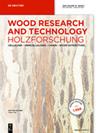热改性、乙酰化和三聚氰胺甲醛树脂浸渍榉木的化学变化
IF 1.6
3区 农林科学
Q2 FORESTRY
引用次数: 0
摘要
木材改性(通过热处理或化学处理)有助于提高木材的尺寸稳定性,并增强其对生物制剂的抵抗力。榉木不耐用,暴露在外部环境中会大大缩短其使用寿命。为了充分发挥榉木在高级应用方面的潜力,需要更好地了解改性引起的化学变化。对榉木进行了两种化学处理(乙酰化和三聚氰胺甲醛树脂浸渍)和三种热处理(加热至 180、200 和 220 °C)。通过傅立叶变换红外光谱法(ATR-FTIR)检测了(i)分子中官能团的变化;(ii)萃取物含量;以及(iii)pH 值的变化。此外,从改性木材中分离出的主要木材成分(纤维素、全纤维素和木质素)的傅立叶变换红外光谱分析也支持对这些变化的解释。热改性过程中对样品施加的高温促进了半纤维素的脱乙酰化和降解。半纤维素也是醋酸酐和三聚氰胺树脂的目标,其粘合作用已通过傅立叶变换红外分析得到证实。形成较少的亚甲基桥会影响三聚氰胺网络的性能。这一观察结果表明,在今后的研究中需要确定最佳固化条件,以降低三聚氰胺木材的亲水性。本文章由计算机程序翻译,如有差异,请以英文原文为准。
Chemical changes in thermally modified, acetylated and melamine formaldehyde resin impregnated beech wood
Wood modification (by thermal or chemical treatment) helps to improve the dimensional stability of wood and enhance its resistance to biological agents. Beech wood is non-durable and exposure in exterior settings dramatically shortens its service life. To determine the full potential of beech wood for advanced applications, a better understanding of the chemical changes induced by modification is needed. Two chemical treatments (acetylation and melamine formaldehyde resin impregnation) and three thermal treatments (heating to 180, 200 and 220 °C) were performed on beech wood. The modification effect was examined based on (i) molecular changes in functional groups by Fourier-transform infrared spectroscopy (ATR-FTIR); (ii) extractive content; and (iii) pH changes. Moreover, the explanation of these changes was supported by the FTIR-analysis of isolated main wood components (cellulose, holocellulose and lignin) from the modified wood. The high temperatures applied to samples during thermal modification promoted the deacetylation and degradation of hemicelluloses. Hemicelluloses were targeted also by acetic anhydride and melamine resin, the bonding of which was confirmed by FTIR analysis. The formation of fewer methylene bridges affected the properties of the melamine network. This observation suggests the need to determine optimal curing conditions in future research, to reduce melamine-wood hydrophilicity.
求助全文
通过发布文献求助,成功后即可免费获取论文全文。
去求助
来源期刊

Holzforschung
工程技术-材料科学:纸与木材
CiteScore
4.60
自引率
4.20%
发文量
83
审稿时长
3.3 months
期刊介绍:
Holzforschung is an international scholarly journal that publishes cutting-edge research on the biology, chemistry, physics and technology of wood and wood components. High quality papers about biotechnology and tree genetics are also welcome. Rated year after year as one of the top scientific journals in the category of Pulp and Paper (ISI Journal Citation Index), Holzforschung represents innovative, high quality basic and applied research. The German title reflects the journal''s origins in a long scientific tradition, but all articles are published in English to stimulate and promote cooperation between experts all over the world. Ahead-of-print publishing ensures fastest possible knowledge transfer.
 求助内容:
求助内容: 应助结果提醒方式:
应助结果提醒方式:


